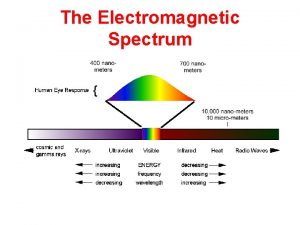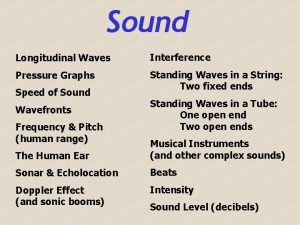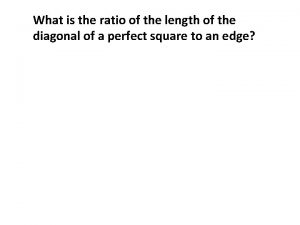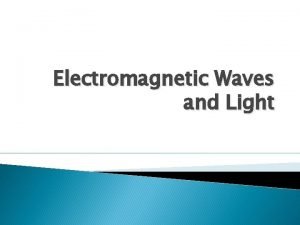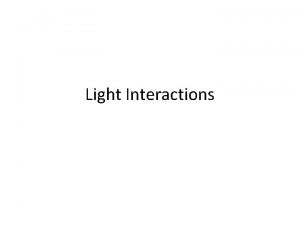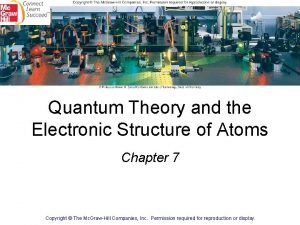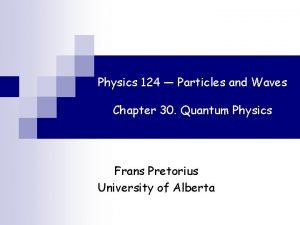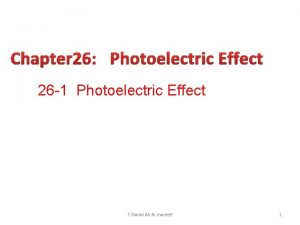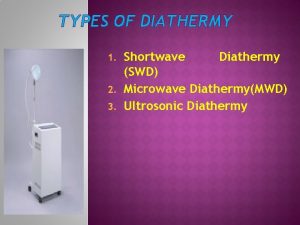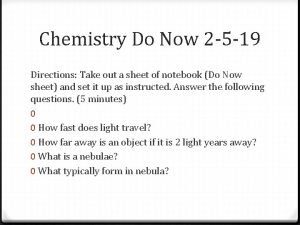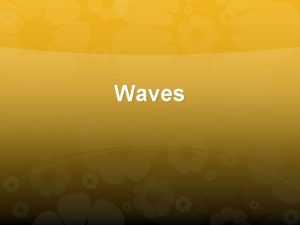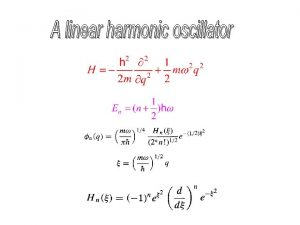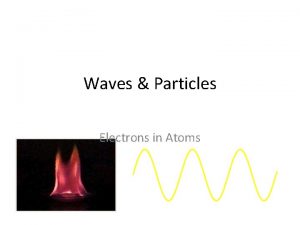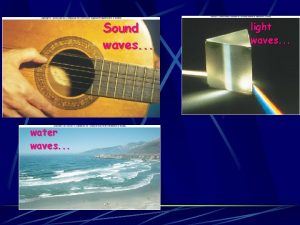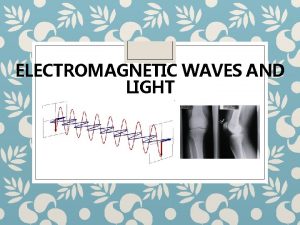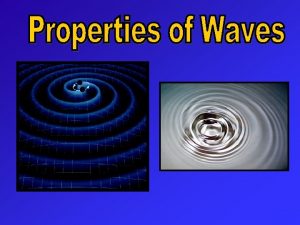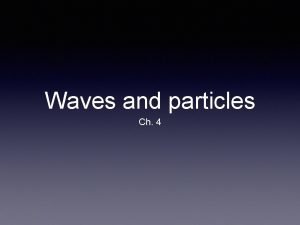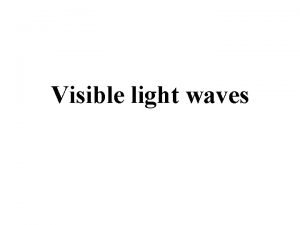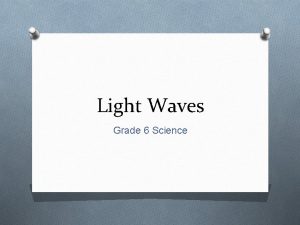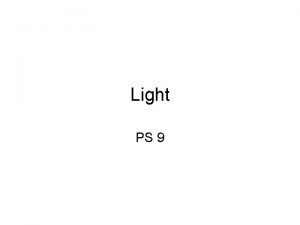What is Light 1 Waves z Wavelength length







































![Periodic Patterns z Example - Germanium [Ar] 2 4 s 10 3 d 2 Periodic Patterns z Example - Germanium [Ar] 2 4 s 10 3 d 2](https://slidetodoc.com/presentation_image_h2/8476e8d607eedb58cabbf5ff5c3dd5b0/image-40.jpg)

![Stability z Electron Configuration Exceptions y. Copper EXPECT: [Ar] 4 s 2 3 d Stability z Electron Configuration Exceptions y. Copper EXPECT: [Ar] 4 s 2 3 d](https://slidetodoc.com/presentation_image_h2/8476e8d607eedb58cabbf5ff5c3dd5b0/image-42.jpg)
![Stability z Electron Configuration Exceptions y. Chromium EXPECT: [Ar] 4 s 2 3 d Stability z Electron Configuration Exceptions y. Chromium EXPECT: [Ar] 4 s 2 3 d](https://slidetodoc.com/presentation_image_h2/8476e8d607eedb58cabbf5ff5c3dd5b0/image-43.jpg)



- Slides: 46

What is Light? 1

Waves z Wavelength ( ) - length of one complete wave z Frequency ( ) - # of waves that pass a point during a certain time period y hertz (Hz) = 1/s z Amplitude (A) - distance from the origin to the trough or crest 2

Waves crest A greater amplitude (intensity) origin trough A greater frequency (color) 3

EM Spectrum H I G H L O W E N E R G Y 4

EM Spectrum H I G H L O W E N E R G Y red R O Y G. orange green yellow B blue I indigo V violet E N E R G Y 5

EM Spectrum z Frequency & wavelength are inversely proportional c = c: speed of light (3. 00 108 m/s) : wavelength (m, nm, etc. ) : frequency (Hz) 6

EM Spectrum z EX: Find the frequency of a photon with a wavelength of 434 nm. GIVEN: WORK: =c =? = 434 nm = 4. 34 10 -7 m = 3. 00 108 m/s -7 m 8 4. 34 10 c = 3. 00 10 m/s = 6. 91 1014 Hz 7

Light is more than waves… z Planck (1900) y Observed - emission of light from hot objects y Concluded - energy is emitted in small, specific amounts (quanta) 8

Niels Bohr’s Model (1913) z. Electrons orbit the nucleus in circular paths of fixed energy (energy levels).

Bohr Model Continued z Electrons can jump from energy level to energy level. z Electrons absorb or emit light energy when they jump from one energy level to another. z A quantum of energy is the amount of energy required to move an electron from one energy level to another.

Energy Levels in Atoms • The energy levels are like the rungs of a ladder but are not equally spaced. Photon - bundles of light energy that is emitted by electrons as they go from higher energy levels to lower levels.

Photons z Einstein (1905) y Concluded - light has properties of both waves and particles “wave-particle duality” 12

Quantum Theory z. The energy of a photon is proportional to its frequency. E = h E: energy (J, joules) h: Planck’s constant (6. 6262 10 -34 J·s) : frequency (Hz) 13

Quantum Theory z EX: Find the energy of a red photon with a frequency of 4. 57 1014 Hz. GIVEN: E=? = 4. 57 1014 Hz h = 6. 6262 10 -34 J·s WORK: E = h E = (6. 6262 10 -34 J·s) (4. 57 1014 Hz) E = 3. 03 10 -19 J 14

Quantum Theory z. The energy of a photon is inversely proportional to its wavelength. E: energy (J, joules) h: Planck’s constant (6. 6262 10 -34 J·s) c: speed of light (3. 00 x 108 m/s) 15

Line-Emission Spectrum excited state ENERGY IN PHOTON OUT ground state 16

Line-Emission Spectrum z Each element has a unique bright-line emission spectrum. y “Atomic Fingerprint” (Helium) The emission lines correspond to photons of discrete energies that are emitted when excited atomic states in the gas make transitions back to lower-lying levels. 17

Hydrogen Line Emission Spectrum Bohr explains the spectrum for Hydrogen, but not for other elements… Quantum Mechanical Model

Part 2: Quantum Mechanics 19

Electrons as Waves z Louis de Broglie (1924) y Applied waveparticle theory to electrons y Electrons exhibit wave properties QUANTIZED WAVELENGTHS: 20

Quantum Mechanics z Schrödinger and “wavefunction” y The wavefunction helps describes the location of the electron, and its probable location 21

Quantum Mechanics z Orbital (“electron cloud”) y Region in space where there is 90% probability of finding an electron Orbital Radial Distribution Curve 22

Quantum Mechanics z Quantum Numbers: y Specify the “address” of each electron in an atom 23

Quantum Mechanics Energy Level ( n ) y Size of the orbital y n 2 = # of orbitals in the energy level 24

Orbital Types z s-orbital: electrons are found within a sphere around the nucleus. s z p-orbital: orbitals that look like “dumbbells or propellers” or tear drops. 25

Orbital Types z d-orbitals: most appear to be the combination of two p-orbitals, “daisy”. 26

Orbital Types z f-orbitals: just crazy! 27

Quantum Numbers zn = # of sublevels per level zn 2 = # of orbitals per level z. Sublevel sets: 1 s, 3 p, 5 d, 7 f 28

Quantum Numbers y. Atom is the filing cabinet y. Each drawer is an energy level y. Folders are sublevels (s, p, d, etc. ) y. Papers in the folder are orbitals 29

Quantum Numbers - Rules z Aufbau Principle y Electrons fill the lowest energy orbitals first. y “Lazy Tenant Rule” 30

Quantum Numbers z Spin Quantum Number (ms or s) y Electron spin +½ or -½ y An orbital can hold 2 electrons that spin in opposite directions. 31

Quantum Numbers - Rules z Pauli Exclusion Principle – Definition 1 y Each orbital can hold TWO electrons, but they must have opposite spins. 32

Quantum Numbers z Pauli Exclusion Principle – Definition 2 y No two electrons in an atom can have the same 4 quantum numbers. y Each electron has a unique “address”: 1. Principal # (n) energy level 2. Ang. Mom. # (l) sublevel (s, p, d, f) 3. Magnetic # (ml) orbital 4. Spin # (ms or s) electron 33

Quantum Numbers - Rules z Hund’s Rule y Within a sublevel, place one e- per orbital before pairing them. WRONG RIGHT 34

Notation z Orbital Diagram O 8 e- 1 s 2 s 2 p z. Electron Configuration 2 2 4 1 s 2 s 2 p 35

Notation z Longhand Configuration S 16 e 6 2 2 2 1 s 2 s 2 p 3 s Core Electrons 4 3 p Valence Electrons z. Shorthand Configuration S 16 e 2 4 [Ne] 3 s 3 p 36

Periodic Patterns s p 1 2 3 4 5 6 7 f (n-2) d (n-1) 6 7 © 1998 by Harcourt Brace & Company 37

Periodic Patterns z Example - Hydrogen 1 1 s 1 st Period 1 st column of s-block 38

Periodic Patterns z Shorthand Configuration y Core e-: Go up one row and over to the Noble Gas. y Valence e-: On the next row, fill in the # of e- in each sublevel. 39
![Periodic Patterns z Example Germanium Ar 2 4 s 10 3 d 2 Periodic Patterns z Example - Germanium [Ar] 2 4 s 10 3 d 2](https://slidetodoc.com/presentation_image_h2/8476e8d607eedb58cabbf5ff5c3dd5b0/image-40.jpg)
Periodic Patterns z Example - Germanium [Ar] 2 4 s 10 3 d 2 4 p 40

Stability z Full energy level z. Full sublevel (s, p, d, f) z. Half-full sublevel 41
![Stability z Electron Configuration Exceptions y Copper EXPECT Ar 4 s 2 3 d Stability z Electron Configuration Exceptions y. Copper EXPECT: [Ar] 4 s 2 3 d](https://slidetodoc.com/presentation_image_h2/8476e8d607eedb58cabbf5ff5c3dd5b0/image-42.jpg)
Stability z Electron Configuration Exceptions y. Copper EXPECT: [Ar] 4 s 2 3 d 9 ACTUALLY: [Ar] 4 s 1 3 d 10 y. Copper gains stability with a full d-sublevel. 42
![Stability z Electron Configuration Exceptions y Chromium EXPECT Ar 4 s 2 3 d Stability z Electron Configuration Exceptions y. Chromium EXPECT: [Ar] 4 s 2 3 d](https://slidetodoc.com/presentation_image_h2/8476e8d607eedb58cabbf5ff5c3dd5b0/image-43.jpg)
Stability z Electron Configuration Exceptions y. Chromium EXPECT: [Ar] 4 s 2 3 d 4 ACTUALLY: [Ar] 4 s 1 3 d 5 y. Chromium gains stability with a half-full d-sublevel. 43

Stability z Ion Formation y Atoms gain or lose electrons to become more stable. y Isoelectronic with the Noble Gases. 44

Stability z Ion Electron Configuration y Write the e- config for the closest Noble Gas y EX: Oxygen ion O 2 - Ne 2 O 10 e [He] 2 2 s 6 2 p 45

Quantum Mechanics z Heisenberg Uncertainty Principle y Impossible to know both the velocity and position of an electron at the same time 46
 What is the shortest electromagnetic wavelength
What is the shortest electromagnetic wavelength Sound waves are electromagnetic waves true or false
Sound waves are electromagnetic waves true or false Wavelength formula with length
Wavelength formula with length List of electromagnetic waves in increasing wavelength
List of electromagnetic waves in increasing wavelength Light light light chapter 23
Light light light chapter 23 Into the light chapter 22
Into the light chapter 22 Chapter 22
Chapter 22 Wavelength of red light
Wavelength of red light Intensity of light calculator
Intensity of light calculator Wavelength of light
Wavelength of light What is the ratio of the length of to the length of ?
What is the ratio of the length of to the length of ? The wave chapter 13
The wave chapter 13 Mechanical and electromagnetic waves similarities
Mechanical and electromagnetic waves similarities Parts of a longitudinal wave
Parts of a longitudinal wave Mechanical and electromagnetic waves
Mechanical and electromagnetic waves What is a semiconductor used for
What is a semiconductor used for Surface waves and body waves
Surface waves and body waves What are the mechanical waves
What are the mechanical waves The difference between constructive and destructive waves
The difference between constructive and destructive waves Mechanical waves and electromagnetic waves similarities
Mechanical waves and electromagnetic waves similarities Is a seismic wave mechanical or electromagnetic
Is a seismic wave mechanical or electromagnetic Difference between electromagnetic and mechanical waves
Difference between electromagnetic and mechanical waves Examples of mechanical and electromagnetic waves
Examples of mechanical and electromagnetic waves Compare and contrast p waves and s waves using venn diagram
Compare and contrast p waves and s waves using venn diagram Sound waves longitudinal waves
Sound waves longitudinal waves Do all em waves travel at the speed of light
Do all em waves travel at the speed of light A lens that bends light waves inward
A lens that bends light waves inward Do light waves transfer energy
Do light waves transfer energy Light interactions
Light interactions Difference between light dependent and light independent
Difference between light dependent and light independent The bouncing off of light
The bouncing off of light Put out the light and then
Put out the light and then Can light block light
Can light block light What is the formula of wavelength
What is the formula of wavelength Compton wavelength
Compton wavelength Constructive interference example
Constructive interference example Hc/wavelength
Hc/wavelength A tuning fork has a frequency of 280 hertz
A tuning fork has a frequency of 280 hertz Diathermy eg microwave
Diathermy eg microwave Which has the longest wavelength
Which has the longest wavelength Wavelength frequency
Wavelength frequency Non thermal effects of short wave diathermy
Non thermal effects of short wave diathermy Amplitude wavelength and frequency
Amplitude wavelength and frequency De broglie wavelength
De broglie wavelength Wifi wavelength
Wifi wavelength Visible wavelength range
Visible wavelength range Wave soeed equation
Wave soeed equation
